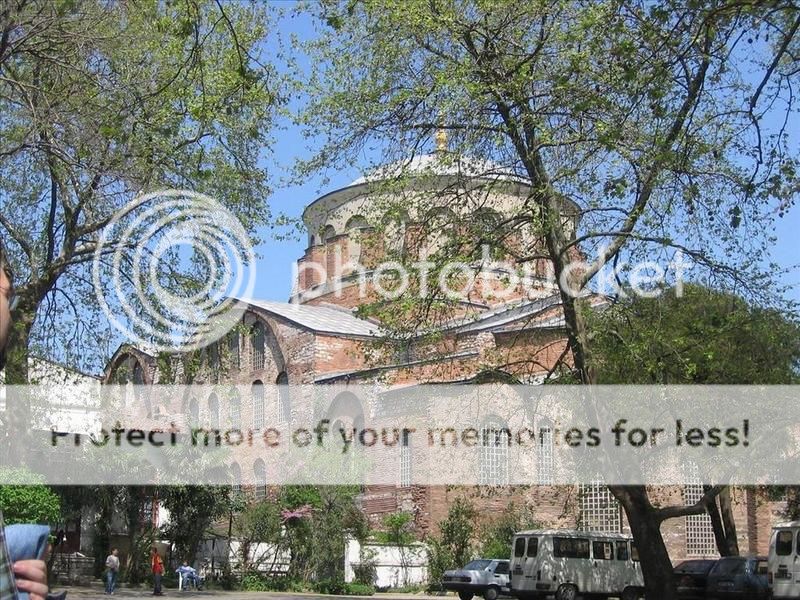GPS : 41°00'34.5"N 28°58'52.0"E / 41.009583, 28.981111

PHOTOGRAPHS ALBUM
Hagia Irene or Hagia Eirene ("Holy Peace", Turkish: Aya İrini), often erroneously rendered in English as St Irene, is a former Eastern Orthodox church located in the outer courtyard of Topkapı Palace in Istanbul. It is open as a museum every day except Monday but requires special permission for admission.
History
Hagia Irene Monument is the only extant church from Byzantine with an atrium. The structure consists of an atrium, a narthex with three naves and an abscissa. Since Hagia Irene Church had not been transformed into a mosque after the conquest (1453), there had not been any modifications made in and out of the structure. The first Ottoman Museum had been established in Hagia Irene Church in 1846, which had been used as Military store with the pieces collected by Damat Ferit Pasha, one of the Armory marshals.
The pieces collected had been organized under two sections, namely the Collection of Ancient Pieces (Mecmua-i Asar-ı Atika) and the Collection of Armament (Mecmua-i Esliha-i Atika); and denominated as Imperial Museum (Müze-i Hümayun). The museum was moved to Tiled Pavilion (Çinili Köşk) in 1875 due to insufficient physical space. The church had been converted into storage and used as a military museum for a while in 1908. After an idle period, the building has become an organizational unit of Hagia Sophia museum.
Church
The building reputedly stands on the site of a pre-Christian temple. It ranks, in fact, as the first church built in Constantinople. Roman emperor Constantine I commissioned the first Hagia Irene church in the 4th century. From May to July 381 the First Council of Constantinople took place in the church. It was burned down during the Nika revolt in 532. Emperor Justinian I had the church restored in 548. It served as the church of the Patriarchate before Hagia Sophia was completed in 537.
Heavily damaged by an earthquake in the 8th century, it dates in its present form largely from the repairs made at that time. The Emperor Constantine V ordered the restorations and had its interior decorated with mosaics and frescoes.
Hagia Irene is the only example of a Byzantine church in the city which retains its original atrium. A great cross in the half-dome above the main narthex, where the image of the Pantocrator or Theotokos was usually placed in Byzantine tradition, is a unique vestige of the Iconoclastic art; presumably it replaced earlier decoration.
The church was enlarged during the 11th and 12th centuries. The church measures 100 m × 32 m. It has the typical form of a Roman basilica, consisting of a nave and two aisles, divided by columns and pillars. It comprises a main space, a narthex, galleries and an atrium. The dome is 15 m wide and 35 m high and has twenty windows.
Entering the church, one descends along a stone ramp to the level of the interior. At the end of the ramp, there is the rear of the church which gives the idea of a basilica, but an unusual type. The eastern dome is supported by four great arches. In this church, the plan is the transition of a pure domed basilica into a Greek-cross plan church.
The apse is a semicircular semidomed above and there are seats for the clergy. In the semidome, there is an ancient mosaic of a simple cross in a black border. At the west, a Turkish wooden staircase leads to the galleries. The galleries and the church was used as an arsenal during the Ottoman Era.
Arsenal
Ottoman helmet, with markings of Saint-Irene arsenal, Constantinople, circa 1520. Musée de l'Armée. After the conquest of Constantinople in 1453 by Mehmed II, the church was enclosed inside the walls of the Topkapı palace. The Janissaries used the church as an armoury. It was also used as a warehouse for war booty.
During the reign of Sultan Ahmet III (1703-1730) it was converted into a weapons museum. It was repaired by Field Marshal Ahmed Fethi Pasha in 1846 and became the first Turkish museum. It was used as the Military Museum from 1908 until 1978 when it was turned over to the Turkish Ministry of Culture.
Concert hall
Today, the museum serves mainly as a concert hall for classical music performances, due to its extraordinary acoustic characteristics and impressive atmosphere. Most of the concerts of the Istanbul International Music Festival have been held here every summer since 1980.
Today, Hagia Eirene hosts Istanbul Art, Cultural and Music Festivals and Istanbul Biennials. Many of the concerts of the Istanbul International Music Festival have been held here every summer since 1980. It is open to public only in festival, concert and biennal times.
LOCATION SATELLITE MAP
WEB SITE : Hagia Sophia Museum Administration
MORE INFO & CONTACT
E-Mail : ayasofyamuzesi@kultur.gov.tr
Phone : +90 212 522 1750 / Tel: +90 212 522 0989
Fax : +90 212 512 5474
These scripts and photographs are registered under © Copyright 2017, respected writers and photographers from the internet. All Rights Reserved.
No comments:
Post a Comment